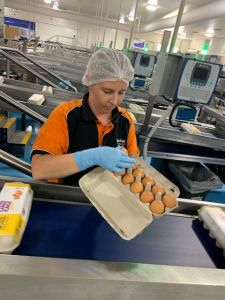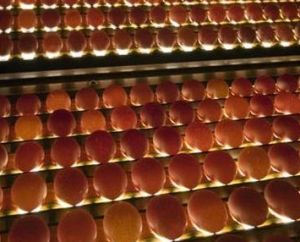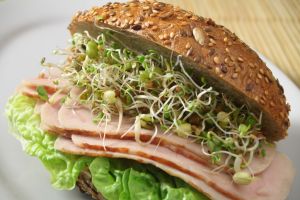This week marks Australian Food Safety Week, with the theme this year being ‘Food safety – raw and risky’.
 As consumers, when we buy food in Australia, we assume that it’s safe. That’s because we trust the many players involved in our food supply chain, from our farmers and transporters to processing facilities and retailers, as well as the regulators that oversee these supply chains.
As consumers, when we buy food in Australia, we assume that it’s safe. That’s because we trust the many players involved in our food supply chain, from our farmers and transporters to processing facilities and retailers, as well as the regulators that oversee these supply chains.
For food to be kept safe, everyone in the supply chain must play their part. For primary producers and processors, this involves managing food safety risks at the point of production, to ensure these risks don’t travel further down the supply chain and make people sick.
So, how do we ensure everyone is doing the right thing? The first step is knowing who is producing the food we eat. In Queensland, those that produce or process meat, eggs, dairy, seafood, or seed sprouts must be accredited with Safe Food Production Queensland. These raw foods carry significant food safety risks if not produced or handled correctly.
To be granted an accreditation, a food business must demonstrate they have the skills and knowledge to produce safe food. This is documented in either a food safety program or management statement.
At a high level, these documents outline:
- What activities the business is undertaking and where
- The food safety risks involved and how they will be managed
- How food safety issues will be identified and resolved.
Our outcomes-based legislation ensures that food safety risks are adequately managed at critical points of production. But what does this look like day-to-day? Here are some examples of how food producers manage “raw and risky” foods to keep you safe:
Dairy processors
All cows milk produced in Australia intended for human consumption must be pasteurised. Pasteurisation ensures milk is safe to drink by killing off harmful bacteria and helps prolong shelf life. It involves heating milk to a high temperature and then quickly cooling it down. Pasteurisation is one of the first steps involved in dairy processing, to ensure the dairy products we know and love, like yogurt, cheese, and ice cream, are made using safe milk.
Egg farmers and processors
 Ever noticed how clean and perfect your eggs look in their carton? That’s no coincidence. Egg producers and processors are required to look for and remove cracked and dirty eggs from the supply chain before they hit supermarket shelves, markets and restaurants.
Ever noticed how clean and perfect your eggs look in their carton? That’s no coincidence. Egg producers and processors are required to look for and remove cracked and dirty eggs from the supply chain before they hit supermarket shelves, markets and restaurants.
Egg shells contaminated with dirt or manure carry obvious risks to human health, but cracked eggs can also pose a risk, creating a pathway for harmful pathogens to infiltrate the egg. Cracked eggs are not always obvious to the human eye. Egg businesses will therefore use both visual inspection and a process called candling (backlighting the eggshell) to help identify hairline cracks.
Meat processors (UCFM)
Uncooked Comminuted Fermented Meat (UCFM), like that salami or chorizo on your charcuterie board, are considered to be high-risk foods. If not processed correctly, they can carry harmful pathogens like Salmonella, Listeria, and E. coli, which can lead to food poisoning. That’s why UCFM products must be fermented (with the optional step of smoking/cooking), to kill off these pathogens. UCFM products must also be separated from raw meat during processing to prevent cross-contamination.
Oyster farmers
Oysters are literally a product of their environment, filtering large volumes of water through their body to produce a strong shell and plenty of meat. For this reason, oyster growers will closely monitor weather conditions that may impact water quality caused by things like run-off or turbulent water. The oyster industry also conducts routine sampling of both the water and oyster meat for coliforms and E. coli to ensure oysters are safe to harvest or pick.
Seed sprout growers
 Seed sprouts, like alfalfa and mung bean sprouts, are often served raw in salads, soups and sandwiches. For this reason, it’s important that they are grown in a controlled environment, to prevent unsafe pathogenic levels of Salmonella, Listeria, and other bacteria. One of the first steps undertaken by growers is a decontamination of seeds before germination. This removes pathogens from within the seed itself, to ensure a healthy plant that is safe for human consumption.
Seed sprouts, like alfalfa and mung bean sprouts, are often served raw in salads, soups and sandwiches. For this reason, it’s important that they are grown in a controlled environment, to prevent unsafe pathogenic levels of Salmonella, Listeria, and other bacteria. One of the first steps undertaken by growers is a decontamination of seeds before germination. This removes pathogens from within the seed itself, to ensure a healthy plant that is safe for human consumption.
These are just some examples of how food producers manage food safety risks during production. As food moves further along the supply chain, these risks are continually managed to ensure the food that reaches your local market, supermarket or café is safe and suitable to eat.
Of course, it doesn’t end there. Food must also be safely managed in the kitchen (especially raw food), to prevent food borne illness. When we all work together and do our part, we can help maintain confidence in Queensland’s food production industry and protect public health.
For more information about what consumers can do to keep food safe, visit:
The Food Safety Information Council: Food safety at home
Queensland Health’s Food Pantry: Food safety for consumers
